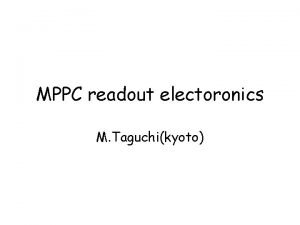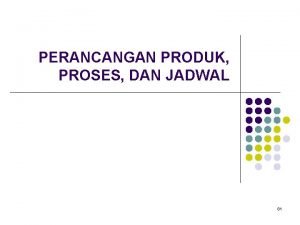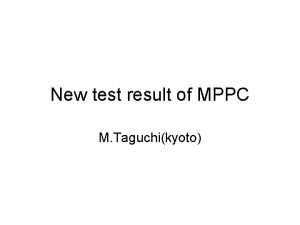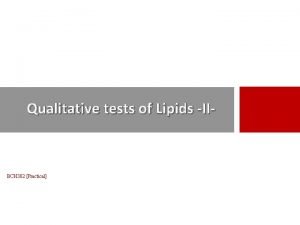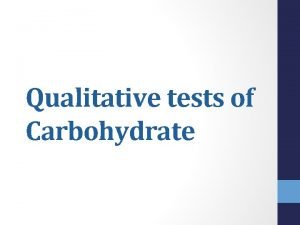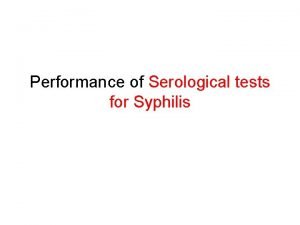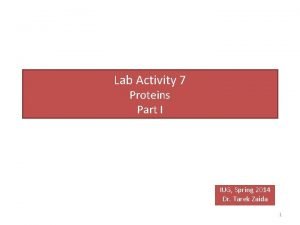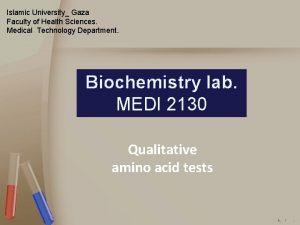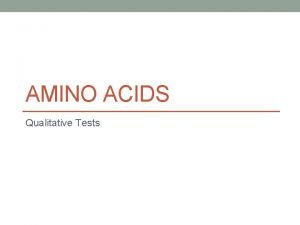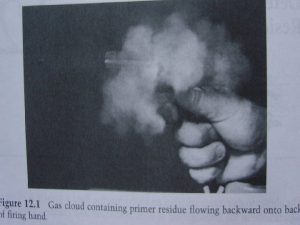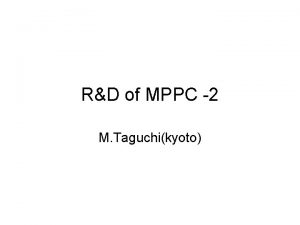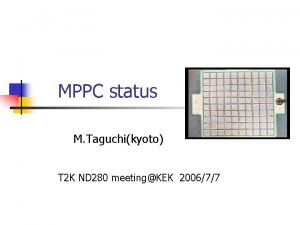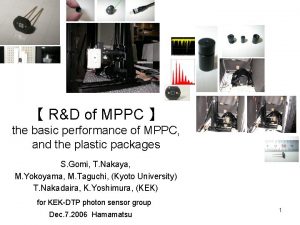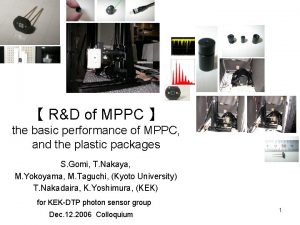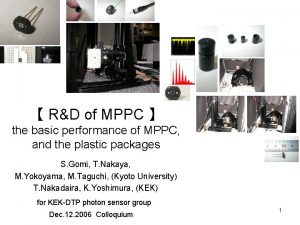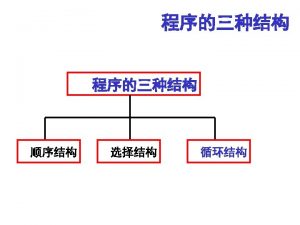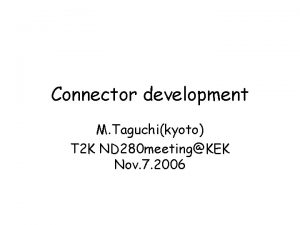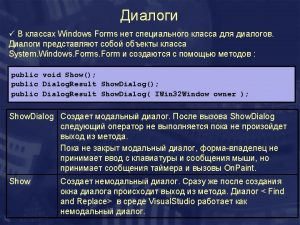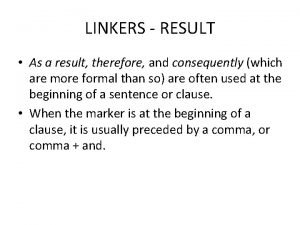New test result of MPPC M Taguchikyoto Contents




















- Slides: 20

New test result of MPPC M. Taguchi(kyoto)

Contents • • New MPPC sample Noise rate, gain, crosstalk rate PDE Long term stability

New MPPC sample recently we got • HPK 32(400 pixel) × 3 Operating voltage : 68~69 V 1 p. e signal width: ~20 ns • HPK 53(100 pixel) × 3 Operating voltage: 68~69 V 1 p. e signal width: ~50 ns • HPK say these have higher PDE than old samples • The test result of HPK 14(100 pixel) that we used at beamtest will be presented for comparison

Noise rate measurement ■ 0. 5 p. e threshold ▲ HPK 53(100 pixel) 1. 5 p. e threshold HPK 32(400 pixel) 1 MHz 100 k. Hz 15℃ 20℃ 25℃ 68. 4 69. 6 Bias voltage 68. 4 69. 4 Bias voltage

Gain measurement@T=20℃ gain 3× 106 HPK 53(100 pixel) • Gain of new samples >105, so satisfy T 2 K HPK 14(100 pixel) requirement 1× 106 HPK 32(100 pixel) 500 k. Hz 0. 5 p. e 1 MHz threshold noise rate

Crosstalk rate measurement@T=20℃ Cross talk rate HPK 14(100 pixel) HPK 53(100 pixel) 0. 2 • Crosstalk rate of new samples is still high 0. 1 (T 2 K requires crosstalk rate<0. 1) HPK 32(100 pixel) 500 k. Hz 1 MHz 0. 5 p. e threshold noise rate

PDE measurement@T=15℃ MPPC ½inch PMT scan 1 mmφfiber 1 mmφslit MPPC ½inch. PMT scan Blue LED 1 mmφfiber • With this set up all the light going through 1 mmφslit inject to the active area of MPPC • Ratio of MPPC p. e to PMT p. e measured by this set up is defined as PDE • With this set up some light from a fiber don`t reach to the active area of MPPC because there is a distance(~0. 8 mm) between surface cover and active area • Ratio of MPPC p. e to PMT p. e measured by this set up is defined as effective PDE

PDE measurement@T=15° • PDE is showed with relative value to PMT HPK 53(100 pixel) HPK 32(400 pixel) ▲ PDE ■ effective PDE HPK 14(100 pixel) 2 2 1 500 900 Noise rate(k. Hz) ノイズレート(k. Hz) 550 ノイズレート(k. Hz) 900 400 900 Noise rate(k. Hz) • PDE of new sample is 2 times larger than that of old one • Effective PDE is 50~60% of PDE We requested the improveme of MPPC packaging to HPK

Raw signal of new sample HPK 53(100 pixel) Noiserate=1345 k. Hz HPK 32(400 pixel) Noiserate=1246 k. Hz • Noise with large pulse height (~ 10 p. e) is observed when noise rate becomes >1 MHz • There is no problem because T 2 K requires noise rate <1 MHz

Long term stability test@T=20℃ • Test the stability of gain, noise rate, p. e for MIP Cosmic ray Trigger counter 4 layers HPK 32(400 pixel) Blue LED MPPC parameter Bias voltage gain 0. 5 p. e th noiserate Crosstalk rate Effective PDE(including crosstalk) ½ inch PMT 68. 8 V 5. 6× 105 800 k. Hz 0. 1 • Cosmic trigger 1. 2 • Pedestal trigger(for monitaring noise rate) 3 different triggers • LED trigger(for monitaring MPPC gain)

Cosmic ray event MPPC PMT 14. 8 p. e 20 60 16. 2 p. e 20 60 p. e

Stability of MPPC gain and noiserate gain Noise rate 5% 5% 839 k. Hz 5. 7× 1 05 5% 5% 40 hour RMS/mean=2. 5% 40 hour RMS/mean=4. 3%

Stability of MPPC Light yield for MIP Peak adc count/gain for MIP 5% 5% 14. 7 p. e 5% 5% 40 hour RMS/mean=4. 0% RMS/mean=2. 9% Correction by gain

summary • New MPPC samples have about 2 times larger PDE than that of old ones • MPPC light yield for MIP~15 p. e (at the point where noise rate and gain satisfy T 2 K requirement) • Gain stability ~3% , noise rate stability~4% • Stability of light yield for MIP~3% (about 2 days)

Back up

LED event MPPC PMT

Staibility of PMT gain 1 p. e adc count 5% 5% 40 hour RMS/mean = 4. 7%

Stability of PMT light yield for MIP Peak adc count/gain for MIP 5% 5% 16. 5 p. e 5% 5% 40 hour RMS/mean=4. 6% 40 hour RMS/mean=3. 1% Correction by gain

Operating voltage range which satisfy T 2 K requirement • HPK 32(400 pixel) Upper limit: 1. 5 p. e th noise rate<50 k. Hz 68. 2~ 68. 8 V Lower limit :PDE >15% • HPK 53(100 pixel) Upper limit: 1. 5 p. eth noise rate<50 k. Hz 68. 3~ 69. 1 V Lower limit:PDE>15%

Recovery time LED 1 HPK 32 (400 pixel) 400 p. e LED 1 LED 2 160 ns • Fire all pixels with LED 1 and study the response of LED 2 with the delay to LED 1 • Saturation signal was observed by LED 2 even with 400 p. e the 120 ns(signal width) delay LED 1 recovery time is about the same as signal width 120 ns LED 2
 Routing sheet pembuatan dadu
Routing sheet pembuatan dadu Mppc
Mppc Rancangan produk rancangan proses dan rancangan skedul
Rancangan produk rancangan proses dan rancangan skedul Mppc
Mppc Acrolein test
Acrolein test Benedict's test mechanism
Benedict's test mechanism Molisch test for carbohydrates
Molisch test for carbohydrates Test for syphilis
Test for syphilis Hopkins cole test positive result
Hopkins cole test positive result Yeast on koh
Yeast on koh Millon's test positive result
Millon's test positive result Hopkins cole test positive result
Hopkins cole test positive result Koh test positive result
Koh test positive result Proline ninhydrin test
Proline ninhydrin test Rinne test
Rinne test Carbohydrate classification
Carbohydrate classification Ninhydrin test for amino acids
Ninhydrin test for amino acids Hexagon agility test clockwise time
Hexagon agility test clockwise time What is paraffin test
What is paraffin test Negative hiv test result
Negative hiv test result Catalase positive bacteria
Catalase positive bacteria

